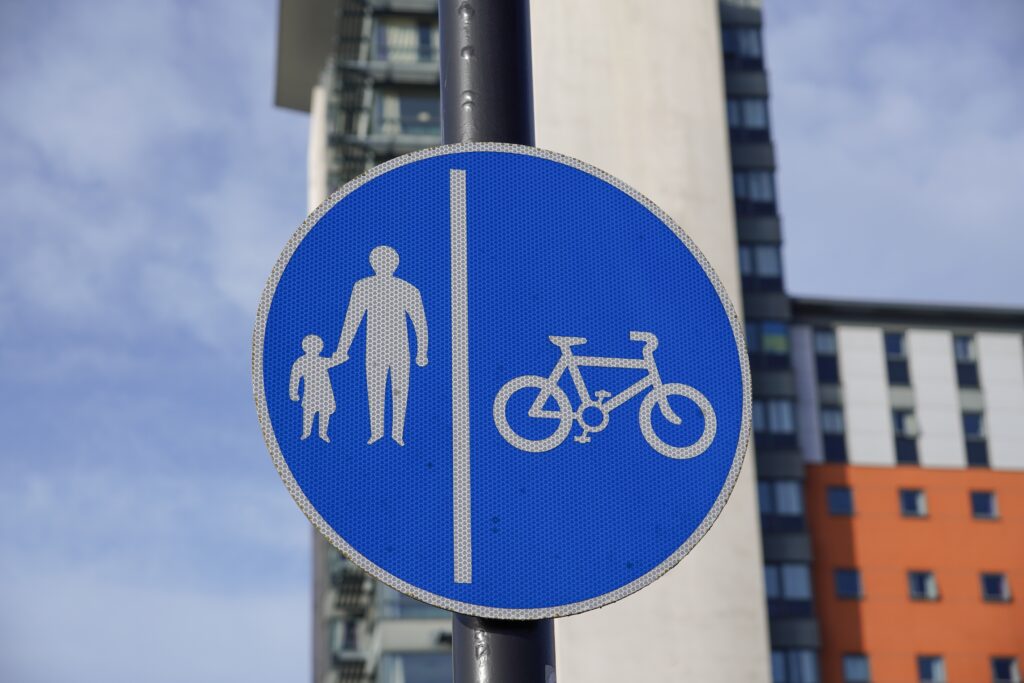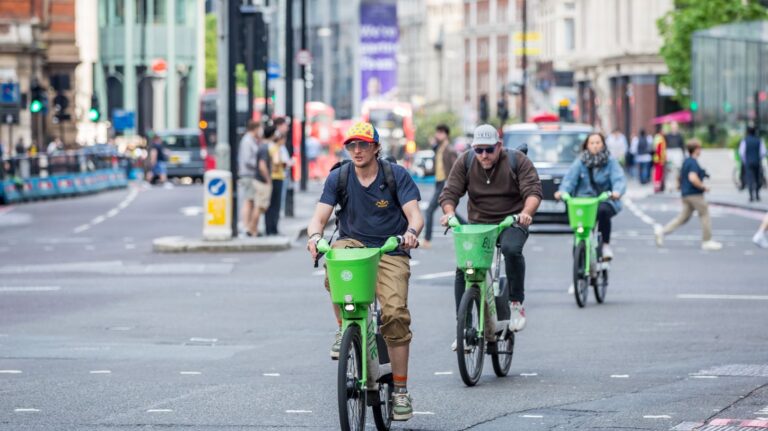With UK government-backed schemes driving the expansion of walking and cycling infrastructure, active travel modes have the potential to redefine modern transport, writes Reuben Henry-Fellows…
Essential for bolstering mental and physical wellbeing, exercise has long been understood to
be a core component of a long and healthy life. The need to be active, long since antiquated by mankind’s technological advancements, has remained irrepressible, its effects compounded by our contemporary constraints. In Britain, since the 1970s, successive governments have introduced myriad policy and legislation encouraging a switch away from primary and secondary industries. As a result, modern Britain operates a highly developed social market economy that focuses on providing financial, consulting and information technology services.
An indirect by-product of this quaternary sector economy is the necessitation of large swaths of the population adopting a sedentary workplace lifestyle. According to Statista, by 2002, 47% of men and 33% of women were classified as overweight, with another 22% of men and 23% of women obese. A House of Commons report published the same year estimated that the associated health costs of overweight Britons was costing the NHS £3.3bn to £3.7bn per annum in England alone. Britain’s quaternary model had fostered obesogenic results.
Since then, the UK government has sought to ameliorate the burgeoning health crisis through a range of advertisements (‘5 A Day’ and ‘Change4Life’), schemes (the NHS’s ‘Healthy Start’ and ‘Better Health’) and legislation (the 2018 Soft Drinks Industry Levy and 2007 smoking ban). Despite the Soft Drinks Industry Levy amassing £355m in tax financial year 2022/23, obesity levels have continued to rise. As of 2024, 25% of the UK population is now obese with a total of 64% classed as overweight, the rising costs of which are estimated to cost the NHS £6.5bn a year. Already proponents of active lifestyles, spending £323m a year between 2015/16 and 2020/21 on supporting grassroots services, the UK government has increasingly focused on a simpler solution – active travel.
Defined as walking and cycling, especially in instances where other forms of powered transportation are available to complete journeys, active travel offers improved health under limited time constraints. When operated in tandem with the plethora of health boosting initiatives already on offer, it is hoped that incorporating exercise into daily routines will negate the effects of sedentary lifestyles.
Since 2020, the Active Travel Fund, created to provide monetary assistance for local authorities to develop and construct walking and cycling facilities, has granted more than £632m in funding. But, with rising obesity rates juxtaposing this funding, how and what should the future of active travel look like in the UK? And as pertains to the individual, how are the funds provided manifesting in the boots (and pedals) on the ground?
Harnessing the workforce
To provide any tangible benefit to the individual, active travel options must be convenient. Factors such as sustainability, speed and cost all act as modulators pertaining to the user’s convenience of options. Accessibility is perhaps the most important convenience modulator within this framework. Ensuring the accessibility threshold remains low has therefore been a primary motivation behind the optimisation of shared mobility provider Lime’s network.
“Key for the customer is the convenience of the service based on parking rules and parking availability,” says Lime’s director of policy for UK and Ireland, Hal Stevenson. “We operate bikes and scooters in London, but the bikes are used much more per vehicle than the scooters because scooter rules are less convenient for the end user.”
FAST FACT: In 2022, 42% of adults walked for travel purposes at least once a week, while 58% walked recreationally. Source: UK Department of Transport
E-mobility, semi or fully powered scooters and bicycles, provide users with a blend of accessible and fast transportation. In major cities, e-bikes and scooters have become ubiquitous to the point of inundation, resulting in outright bans of e-scooters in Paris and Melbourne, restrictions in Brussels and New York, and public transport prohibition in London and Berlin. This, in turn, has affected how e-bikes are perceived.
“There are reputational issues with e-scooters in the UK because most e-scooters people see and interact with on the street are illegal,” Stevenson says. “In terms of e-bikes, there has been so much improvement in places you can ride your bike; cycle lanes through low traffic neighbourhoods and on cycle superhighways – but there hasn’t been the same level of investment or improvement in places you can park your bike and that needs to happen.”
Lime, like other shared mobility operators, is predicated on the assumption that local councils and governments will provide adequate infrastructure for their vehicles to become viable options for supporting active travel. Without the infrastructure or – in the case of e-scooters in the UK – a receptive culture, behavioural changes become less likely. Thus, Active Travel England (ATE) was launched in 2022 as the official government body in charge of investing in schemes and initiatives to create walking and cycling routes across the country.
Since becoming fully operational in 2023, ATE has invested more than £245m into 260 miles of walking and cycling routes and hundreds of safer crossings and junctions. Additionally, ATE has earmarked some £3.2bn for modernisation investment, updating and providing future highways to facilitate further active travel developments. In essence, by creating infrastructure, ATE can facilitate private operators who, in turn, offer Britons cost-effective active travel solutions. Funding, consulting and training councils to run their own active travel schemes further incentivises private operators to expand their services.
“Enabling more people to walk, wheel or cycle to where they need to be is one of the most effective actions, we can take to build a happier, healthier and greener nation,” says national active travel commissioner – and former professional cyclist and Olympic gold medallist – Chris Boardman. “Whether it’s for getting to work, school, the shops, or just out and about for exercise, it’s vital that every adult and child can enjoy the vast physical and mental health benefits of having safe, high-quality active travel options in their local areas.”

“Enabling more people to walk, wheel or cycle to where they need to be is one of the most effective actions, we can take to build a happier, healthier and greener nation.” – Chris Boardman, national active travel commissioner, Active Travel England
Additionally, ATE acts as a statutory consultee on all new large developments, enabling it to review more than 1,500 planning consultations covering 200,000 households and 500,000 people. Reducing the strain on public transport, especially on rail, where fares rose by 4.3% in 2023 and by 5% in 2024 due to increased demand for limited capacity, has also proven beneficial. Boardman continues: “We’re investing hundreds of millions of pounds and working with councils, developers and organisations up and down the country to help make sure everyone has those choices – whether they live in cities, towns or rural communities.”
Meanwhile, Lime and other shared e-bike operators are providing a cost-effective way of contributing to active travel schemes because these organisations run their services at no cost to the council. “We’re able to fund the building of infrastructure and can deliver wider social value through funds that we launch,” says Stevenson. “It’s about making the case for why shared e-bikes can make a positive contribution and demonstrating that they can be managed responsibly.”
Grass beneath our feet
When managed correctly, active travel has the potential to quickly become the most effective method of transportation, but accessing new cycleways and paths remains an obstacle for those who would benefit the most. Inequalities in transport funding and services disproportionately affect lower income people and people living in lower income areas. A 2023 Social Market Foundation study estimated that 8% of the UK population are kept in poverty by transportation costs, while the UK government’s National Travel Survey of the same year asserted that 48% of those in the poorest population fifth did not have access to a car.
Whilst ATE-funded projects seek to eliminate cost barriers, they don’t necessarily directly target people on the ground. For mobility providers, this presents an opportunity to create demand and bolster their image while facilitating a tangible benefit to local communities. For example, Lime’s ‘Share the Joy’ campaign sought to provide funds for active travel initiatives that provide access to disadvantaged or underrepresented groups. “We’ve invested £100,000 with £20,000 already allocated to the first nine recipients,” says Stevenson. Of those, Wheels for Wellbeing, Cycle Sisters, London Bike Kitchen, Upcycle London and Women of Colour Cycling have already used their funds for training, equipment and repairs.

Acting as a link between government policy and community action, these schemes can create a positive active travel culture that reduces congestion, decreases reliance on NHS services through improved cardiovascular health and decreases local air pollution. Despite Statista reporting that cycling participation rose from five million to 7.3 million between 2016 and 2023, and 22.6% of people in England stating that they go for a leisure walk at least five times a week, active travel was conducted for commuting half as much as it was for recreation. How communities sustain these links and reinforce a positive cultural shift toward active travel will ultimately impact the viability of ATE and the schemes it chooses to implement.
Walk this way
Funding is imperative to fostering active travel, but so is time. In 1996, Great Britain attended the Atlanta Summer Olympics with 306 athletes and won a single gold medal. When, a year later in 1997, the British Olympic committee began formulating the bid for what would eventually become the 2012 London Olympics, a concerted effort was made to ensure UK athletes were ready.
A ruthless focus on sports built around coachable skills less reliant on individual genius such as rowing, cycling and sailing was adopted, supported by the launch of the National Lottery, which siphoned funds into sports. From Sydney 2000 to London 2012, UK Sport estimates funding rose from £37m to £214m and now averages £222m per summer games. The result was a third-place medal finish in 2012 and the UK now leading the all-time medal table in cycling and rowing. Athletic excellence was mirrored in public want for sport, expenditure on recreational sport and sporting services rising from £7.5bn in 2005 to £13.7bn in 2022 – a 38% increase since London 2012 alone.
FAST FACT: If 10% of trips in urban areas were made by bicycle instead of car, the UK could cut carbon emissions by 7.7 million tonnes annually. Source: Sustrans
For the Olympics, funding acted as an accelerator for a cultural shift that demanded funds to continue existence. Even so, it took a new generation of athletes, buoyed by years of top-level coaching and competition – for active travel, the change can start today.
“There’s clear demand for it,” Stevenson concludes. “You can see how many people use it, and it’s right that people are trying to use more sustainable forms of transport rather than relying on cars. There are clear benefits to cycling in cities such as London, where the infrastructure is there and it’s a safe and sustainable way to get around. We’re really focused on making sure everyone feels like they’re able to cycle and cycling is for them.”
This article was originally published in the September 2024 issue of CiTTi Magazine.
Achievements and innovations in active travel will be celebrated at the third annual CiTTi Awards, which will be held on 26 November 2024 at De Vere Grand Connaught Rooms in London. Please visit www.cittiawards.co.uk to learn more about this unmissable event for the UK’s transportation sector – and to book your table!





